Home | Tours | Trip Reports | News | Team | Calendar | Links | Contact | Store | Mailing List
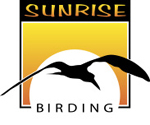
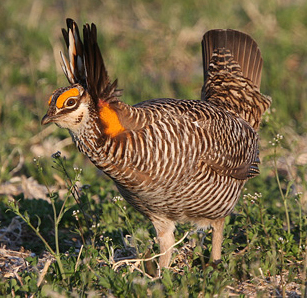 COLORADO
COLORADOCHICKENS
Trip Report
April 16 - 26, 2009
Leaders: Luke Tiller & Joe Bear
Download report (pdf, no photos)>> Trip List (pdf)>>
Day 1
Arriving a little early at Denver International Airport thanks to some buffeting headwinds we touched down, picked up our 2 hours of inherited time (thanks to the Rocky Mountains) and joined the insanely jolly air train to go pick up our baggage. Whilst picking through the 1001 black suitcases on the conveyor we met our British representative and zipped over to pick up our transport for the next 10 days.
Everything was running nice and smoothly thus far and we were out of the Airport, not before picking up a beautiful light morph Swainson’s Hawk coursing the runways at DIA, and on the road for our first birding destination up into the mountains of Rocky National Park, the Fawn Brook Inn.
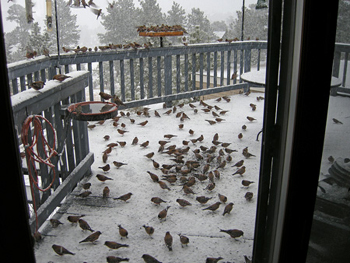 Surrounded by stunning scenery, The Fawn Brook has developed a reputation as being one of the few places in the continent that you are almost guaranteed to see all three Rosy-finches in winter. Rosy-finches are probably some of the continents most enigmatic and sought after birds due to their predilection for breeding in extreme sites across the US. In winter however, they can be locally found in mixed flocks in limited mountainous areas across the Southwest. Rosy-finches are a blur of colors that are all suffused with a wonderful pinkish glow and their beauty and habit for choosing such challenging environs makes them a huge draw.
Surrounded by stunning scenery, The Fawn Brook has developed a reputation as being one of the few places in the continent that you are almost guaranteed to see all three Rosy-finches in winter. Rosy-finches are probably some of the continents most enigmatic and sought after birds due to their predilection for breeding in extreme sites across the US. In winter however, they can be locally found in mixed flocks in limited mountainous areas across the Southwest. Rosy-finches are a blur of colors that are all suffused with a wonderful pinkish glow and their beauty and habit for choosing such challenging environs makes them a huge draw.
The main problem is that to see Rosy-finches one needs some bad weather to bring them into the feeders, but at the same time you want to make sure that the weather is not bad enough to make the roads to the feeders that you are hoping to get to impassable. It’s a real tight-rope walk.
We flew in to weather that seemed just bad enough and we hoped that the dipping temperatures and promise of some sleety snow would have the feeders well stocked with birds. However on arrival the feeders themselves were looking a little poorly stocked. Undeterred we jumped out the car and started to quickly pick up some entertaining birds. ‘Gray headed’ Dark-eyed Juncos swarmed the feeders and amongst them we managed to pick out ‘Pink-sided’ and ‘ Oregon’. Beautiful Cassin’s Finches hopped around the feeders too and a veritable host of Pine Siskins joined the throng. We were slowly picking up a nice selection of birds as Mountain Chickadees and Steller’s Jays swept past us or loitered on the feeders but the sought after Rosy Finches were a no show. As we moved around watching the various feeders we managed to pick up more and more nice birds but our quarry was elusive. It was then that another car of birders showed and they quickly turned us on to a Rosy-finch that was using a feeder that was hidden from our view where there was a beautiful adult Brown-capped. A nice tick for everyone involved but hardly the throngs we had been hoping to find.
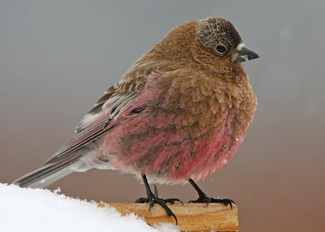 With the Brown-capped studied, photographed and thoroughly enjoyed we decided to leave this mountain redoubt and try a second spot that had been suggested to us by our Colorado inside source. Before we left however we had time to ponder the sudden excitement that surged through the loitering corvids (both American Crows and Common Ravens) whatever it was it didn’t seem to present itself to us, and to explore a couple of little side roads around the Inn for other feeders Here we found another nice little mix of mountain specialties including a few cracking looking Pygmy Nuthatches (so cute!) and a couple of Rocky Mountain White-breasted Nuthatches that showed the much duskier coloration of this subspecies.
With the Brown-capped studied, photographed and thoroughly enjoyed we decided to leave this mountain redoubt and try a second spot that had been suggested to us by our Colorado inside source. Before we left however we had time to ponder the sudden excitement that surged through the loitering corvids (both American Crows and Common Ravens) whatever it was it didn’t seem to present itself to us, and to explore a couple of little side roads around the Inn for other feeders Here we found another nice little mix of mountain specialties including a few cracking looking Pygmy Nuthatches (so cute!) and a couple of Rocky Mountain White-breasted Nuthatches that showed the much duskier coloration of this subspecies.
After enjoying a little impromptu birding we got back on the road to Estes Park Colorado to look for more Rosies. After spotting a few roadside American Elk and a few Western and Mountain Bluebirds en route we were soon in Estes Park and had our eyes set on a distant but huge flock of Rosy-finches. Using scopes we scanned through the flock hopeful of picking out something new but were disappointed as they left. We relocated the flock hitting the feeders of a nearby house. As the door of the house opened we expected to be asked to maybe move on or what we were up to, instead we had a welcoming invite into the house to view the birds from the comfort and warmth of the kitchen.
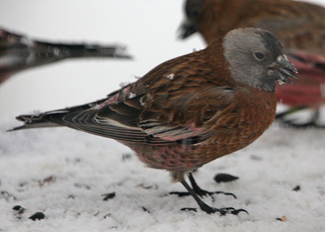 The Rosy-finch flock was huge and from the throngs we soon had picked out a Black Rosy-finch. While we were waiting, our host, Scott was busy banding the little cuties and we soon had an opportunity to study these birds up close and personal and even got to let a few go – pretty magical – holding a bird that many US birders have never even seen! Scott then informed us that his friend Jim down the road seemed to have a few Grey-crowneds lingering at his feeders so we decided to hot-foot it over there and see what we could see. We were not to be disappointed as Jim had a whole slew of the finches at his feeders including the Grey-crowned. As great as it was to get a new bird, really the highlight was just the unbelievable sight of hundreds of these incredible birds mobbing the surrounding feeders.
The Rosy-finch flock was huge and from the throngs we soon had picked out a Black Rosy-finch. While we were waiting, our host, Scott was busy banding the little cuties and we soon had an opportunity to study these birds up close and personal and even got to let a few go – pretty magical – holding a bird that many US birders have never even seen! Scott then informed us that his friend Jim down the road seemed to have a few Grey-crowneds lingering at his feeders so we decided to hot-foot it over there and see what we could see. We were not to be disappointed as Jim had a whole slew of the finches at his feeders including the Grey-crowned. As great as it was to get a new bird, really the highlight was just the unbelievable sight of hundreds of these incredible birds mobbing the surrounding feeders.
With great birds and amazing experiences under our belt and all in the first half day we set off, as a snow storm closed in, on our way to Golden, Colorado for a beverage and a good night’s sleep.
Day 2
We awoke the next day to the news that we had dreaded. The storm that we had hoped might scoot by us had closed in and was currently smashing into the area west of Denver. Things were looking unpromising as far as getting to our target bird of the day, White-tailed Ptarmigan, with the pass that we needed to use to get to it being firmly closed. With some sadness and the ptarmigan officially out of bounds we decided to grab some breakfast, scrap the bird from the list and continue with our plans to get north and west and continue with the original route for the day. As we left Golden, it was raining lightly but as we climbed into the mountains the precipitation quickly turned into a beautiful blanket of snow.
Although conditions were deteriorating fast we decided to hop off of I-70 to give ourselves a shot at a much wanted Williamson’s Sapsucker. We arrived at a staked out site in a foot or so of snow and with more snow rapidly piling upon us. Things didn’t look very promising at all but with snow falling as we slowly searched the surrounding pines there was a surprising amount of bird activity including Mountain Chickadees, Mountain Bluebirds and then a sight for sore eyes a stunning male Williamson’s Sapsucker, possibly the most beautiful of all woodpeckers. It performed admirably for a few minutes before we decided to hot tail it out of there and get on with our days journey.
Our final destination for the day was Walden, Colorado but with some lousy weather closing us in we decided to have a quick stop at the rather picturesque town of Georgetown. We had been tipped off that bird feeders in town might be quite profitable but on arrival it appeared that the main regular bird feeder in town had moved. Still there was much to enjoy in this attractive town and we soaked up the atmosphere and grabbed a coffee before venturing out for a little birding. Highlights at the stop included a small and very mobile flock of Band-tailed Pigeons, a Steller’s Jay or two, which one always seems to have to work hard to see but not hear, as well as a rather attractive pair of Townsend’s Solitaires.
Backtracking a little on I-70 we were soon winging our way north. Little did we know that just hours after we had passed the pass that we had taken to get north towards Walden it was closed along with 70 miles west of Denver (a close escape that could have really thrown a spanner into the works). Escaping the storm now we were soon on to a couple of excellent mountain lakes to check out, after a quick roadside stop to admire a flock of Red Crossbills that Frank had miraculously spotted whilst careening along at 50 mph in thick snow, and we were soon surrounded by a stunning array of waterfowl. Barrow’s Goldeneye were ridiculously common and there was an absolutely incredible number and variety of waterfowl to enjoy (over a dozen species including Canvasback and Redhead) as well as a briefly viewed Sage Thrasher and a number of American Pipits, the stunning salmon pink of the alticola subspecies glowing against the winter snows. Other neat sightings here included 4 gull species, including Franklin’s Gull as well as a little less expected Bonaparte’s.
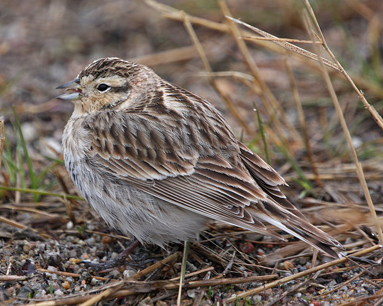 After soaking up the wonderful waterfowl stop we were on our way to Walden for the night. The next stop however was completely unplanned as we started to hit little flocks of passerines that had seemed to have been knocked down by the awful weather. A little farm building on the edge of the Arapaho National Forest drew our attention as flocks of sparrows, juncos and Horned Larks flushed from the driveway and roadside. Our excitement levels rose when we quickly realized that there were longspurs in amongst them, first stunningly beautiful male McCown’s and then amongst some dowdy female type birds a trip highlight, a possible basic plumaged male Chestnut-collared Longspur. This was when everyone’s real birding skills kicked in as we tried to track and study this beautiful but cryptic individual, all the while trying not to lose him in the swirling flocks. Eventually he settled down and allowed close approach to within just a few feet and pictures were quickly reeled off of this fascinating and challenging bird - a fantastic birding moment.
After soaking up the wonderful waterfowl stop we were on our way to Walden for the night. The next stop however was completely unplanned as we started to hit little flocks of passerines that had seemed to have been knocked down by the awful weather. A little farm building on the edge of the Arapaho National Forest drew our attention as flocks of sparrows, juncos and Horned Larks flushed from the driveway and roadside. Our excitement levels rose when we quickly realized that there were longspurs in amongst them, first stunningly beautiful male McCown’s and then amongst some dowdy female type birds a trip highlight, a possible basic plumaged male Chestnut-collared Longspur. This was when everyone’s real birding skills kicked in as we tried to track and study this beautiful but cryptic individual, all the while trying not to lose him in the swirling flocks. Eventually he settled down and allowed close approach to within just a few feet and pictures were quickly reeled off of this fascinating and challenging bird - a fantastic birding moment.
The day was already somewhat drawing to a close and we decided to get on the road again for our final destination. As we approached Walden the sun was going down but in the darkened shadows we spotted a large Moose leaving a small stand of trees as we pulled over to admire this magnificent animal Gary spotted a young Golden Eagle perched in the tree behind him. What a magical end to the diurnal portion of the day’s birding.
After a hearty meal and Gary’s not so successful experimentation with Chicken-fried Steak we decided to throw caution to the wind and have a bash at finding Boreal Owls. Without giving away too many details we managed to successfully track down one of these most ethereal of bird singing heartily at midnight. However although the bird was singing repeatedly just a few feet away we just couldn’t seem to see the darn thing as it teasingly called from close by, seemingly flew over us to the other side of the road and back again. Not wanting to disturb him anymore we left without a sighting but with an indelible memory of that mid-night calling bird hauntingly accompanying us on a dark and eerie mountain pass.
Day 3
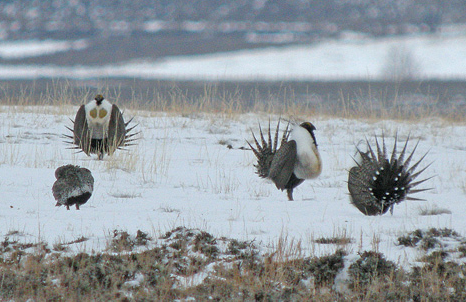 After what felt like an all too short night’s sleep we were up pre-dawn for a run out to look for our first chicken lek. We arrived at the appointed place and scanned carefully in the morning gloom trying various sites along the road as we tried to discover the Greater Sage Grouse leks current location. As dawn rose we were suddenly on them as they vocalized and performed furiously in the surrounding sage brush, a magical moment, as we observed this rather fantastic display and soaked up the atmosphere of the plains and surrounding snow encrusted mounts as these forty or so grouse displayed on the snow covered ground. With photos snapped we were on with our journey.
After what felt like an all too short night’s sleep we were up pre-dawn for a run out to look for our first chicken lek. We arrived at the appointed place and scanned carefully in the morning gloom trying various sites along the road as we tried to discover the Greater Sage Grouse leks current location. As dawn rose we were suddenly on them as they vocalized and performed furiously in the surrounding sage brush, a magical moment, as we observed this rather fantastic display and soaked up the atmosphere of the plains and surrounding snow encrusted mounts as these forty or so grouse displayed on the snow covered ground. With photos snapped we were on with our journey.
There were however a few little productive ponds to check on the way back to town for breakfast and we had soon managed to add Sandhill Cranes, Bald Eagles on a nest, Common Loon, Horned Grebe, Cinnamon and Blue-winged Teal and Wilson’s Snipe amongst others to our trip haul.
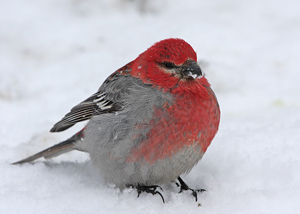 Post breakfast and we were on towards our next port of call the enticing feeder action at the Moose Visitors Center. In the harsh winter landscape of mountainous Colorado it seems that where there are feeders there are multitudes of birds and Moose was no different. Here we delighted in seeing a wealth of birds making use of the free lunch including any number of Junco’s, Cassin’s Finch, Pine Siskins aplenty, highlights included a few Brown-capped Rosy-finches, a seemingly out of place Great-tailed Grackle and Brewer’s Sparrow, and most importantly a few much sought after Pine Grosbeaks.
Post breakfast and we were on towards our next port of call the enticing feeder action at the Moose Visitors Center. In the harsh winter landscape of mountainous Colorado it seems that where there are feeders there are multitudes of birds and Moose was no different. Here we delighted in seeing a wealth of birds making use of the free lunch including any number of Junco’s, Cassin’s Finch, Pine Siskins aplenty, highlights included a few Brown-capped Rosy-finches, a seemingly out of place Great-tailed Grackle and Brewer’s Sparrow, and most importantly a few much sought after Pine Grosbeaks.
In the open lands to and from Moose we were treated to a nice mix of hunting raptors including a couple of stunning Rough-legged Hawks, a Swainson’s or two, Golden Eagle and a few Northern Harriers. One of the highlights of the day was a nesting Swainson’s Hawk that we had discovered that was suddenly rudely interrupted by a Golden Eagle that honed into view across the prairie. We were treated to a long and stunning show as the two Swainson’s joined up to do battle with the rather lumbering Golden Eagle before they finally saw it off.
Next stop was Rabbit Ears pass in the hopes of some more mountain passerine specialties and woodpeckers however as is often the case with these large swathes of coniferous forest, sites can either be feast or famine and in this case we were left somewhat hungry. After another hearty breakfast we were on our way again.
This afternoon our main target was to get over to Hayden, Colorado and scout out some of the leks that we were planning on hitting the next morning, we swung past the Sharp-tailed Grouse lek with no joy and then headed to an evening spot where we hope to find Dusky Grouse. Whilst set up and scopes twirling this way and that looking for our quarry we were entertained by a host of local wildlife: we had soon picked out a lone Greater Sage Grouse strutting his stuff, Western Meadowlarks were everywhere, a Prairie Falcon momentarily perched on a distant post and a North American Porcupine wandered lazily through the sagebrush in front of us and then finally as the light dimmed across this scenic valley there was a Dusky Grouse booming almost inaudibly across the field. An amazing sight as we watched his stunning purple air sacks inflate and deflate as he displayed to a female lost somewhere in the brush - beautiful.
Day 4
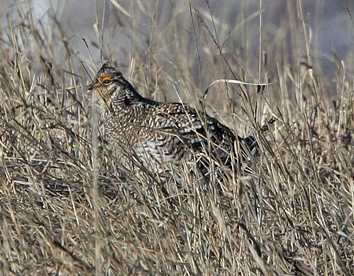 This day saw us rising early again and out to the Sharp-tailed Grouse leks. We knew exactly where to find them and as we waited in the car in the dark we could slowly hear the eerie vocalizations start to fill the cool morning sky. As the sun rose we worked our way to enjoy good looks at the birds as the performed on their ridge-top dancing grounds. Their performance was incredible and it was easy to see why the plains Indians were so influenced in their dancing rituals by these incredible leaping and cavorting birds. There was much toing-and-froing from the lek allowing good looks at he birds in flight as well. After a good long audience with the birds and more pictures fired off we were on the road again, stopping momentarily to enjoy a Dusky Grouse that was curiously sat out in the open in a recently planted agricultural field.
This day saw us rising early again and out to the Sharp-tailed Grouse leks. We knew exactly where to find them and as we waited in the car in the dark we could slowly hear the eerie vocalizations start to fill the cool morning sky. As the sun rose we worked our way to enjoy good looks at the birds as the performed on their ridge-top dancing grounds. Their performance was incredible and it was easy to see why the plains Indians were so influenced in their dancing rituals by these incredible leaping and cavorting birds. There was much toing-and-froing from the lek allowing good looks at he birds in flight as well. After a good long audience with the birds and more pictures fired off we were on the road again, stopping momentarily to enjoy a Dusky Grouse that was curiously sat out in the open in a recently planted agricultural field.
En route for our next stop we were happily delayed by a few small roadside ponds and agricultural fields that netted us more Sandhill Cranes, our first stunning Cinnamon Teals and most excitingly a flock of fifty or so stunning White-faced Ibis. After a first few days of blizzards, snow and mountain passes it was almost bizarre to find oneself birding in a dusty dried up riverbed and sea of sagebrush dressed in t-shirts and slathered in sunscreen. Here we were targeting a couple of specialties and although we had had brief looks at one earlier we were much more pleased with our tee’d up 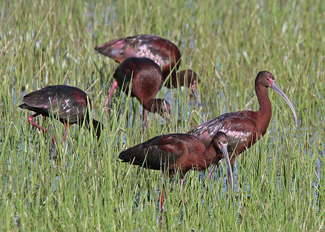 and singing Sage Thrasher views here. We also managed to eventually dig out our main quarry for the stop a few rather beautiful Sage Sparrows. Being a big sparrow fan, this was a real highlight for me personally.
and singing Sage Thrasher views here. We also managed to eventually dig out our main quarry for the stop a few rather beautiful Sage Sparrows. Being a big sparrow fan, this was a real highlight for me personally.
On we drove again. It seems that I have barely mentioned the scenery but it was again stunning as we hit incredible rocky outcroppings carved out by the Colorado River, like driving through a Western Movie. En route we had picked up a seemingly incredible six Golden Eagles and an afternoon stop netted us our first Canyon Wren, Says Phoebe as well as Black-throated Sparrow and a few jaunty Rock Wrens. Chukar one of our targets here wouldn’t play ball and a group of Pinyon Jays that were calling from the nearby hillsides remained all too elusive, still it was a beautiful stop and as the sun set we enjoyed watching as hordes of White-throated Swifts ducked in and out of their imposingly impressive cliff-face colonies.
Day 5
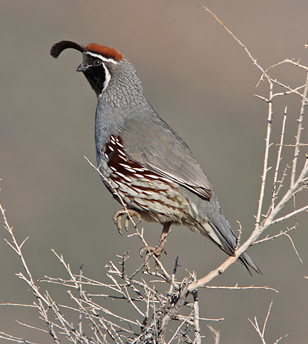 This day started with a trip out to Colorado National Monument, a stunning site with amazing vistas and stunning red sandstone cliffs al bathed in a warming sun. The allure of the place was the expected Pinyon/Juniper specialties. First stop were a couple of suburban spots where we hoped to find a few local specialties such as Gambel’s Quail. We were not to be disappointed as we soon had a few coveys zipping through the brush and giving their distinctly cockneyeqsue “awlright” call. As we entered the national monument we were soon into the action with Bewick’s Wren, Western Scrub Jay and Juniper Titmouse all presenting themselves for views. Another campground stop provided more of the same as well as unforgettable views of a couple of recently arrived Black-throated Grey Warblers that Joe’s well tuned ears had picked up as they marked out their summer territories. The site was a memorable one and with the early morning sun at our backs we enjoyed the scenery as much as the birding. Other nice pick-ups were to be had here as we managed to stumble upon a large flock of the beautiful and much sought after Pinyon Jay, a Peregrine Falcon and a few cheeky little Bushtits working the scrub.
This day started with a trip out to Colorado National Monument, a stunning site with amazing vistas and stunning red sandstone cliffs al bathed in a warming sun. The allure of the place was the expected Pinyon/Juniper specialties. First stop were a couple of suburban spots where we hoped to find a few local specialties such as Gambel’s Quail. We were not to be disappointed as we soon had a few coveys zipping through the brush and giving their distinctly cockneyeqsue “awlright” call. As we entered the national monument we were soon into the action with Bewick’s Wren, Western Scrub Jay and Juniper Titmouse all presenting themselves for views. Another campground stop provided more of the same as well as unforgettable views of a couple of recently arrived Black-throated Grey Warblers that Joe’s well tuned ears had picked up as they marked out their summer territories. The site was a memorable one and with the early morning sun at our backs we enjoyed the scenery as much as the birding. Other nice pick-ups were to be had here as we managed to stumble upon a large flock of the beautiful and much sought after Pinyon Jay, a Peregrine Falcon and a few cheeky little Bushtits working the scrub.
Next stop was our slam dunk for Lewis’s Woodpecker and a marshy reservoir with excellent other possibilities. A little early for much in the way of shorebird migration although we did pick up our first Greater Yellowlegs we still managed to make the most of this stop and a wealth of waterfowl including stunningly close views of both Clark’s and Western Grebes that posed admirably for pictures. From the marshes Marsh Wrens gurgled and eventually presented themselves. A possible future split, the subtle difference in the song was noted by the group.
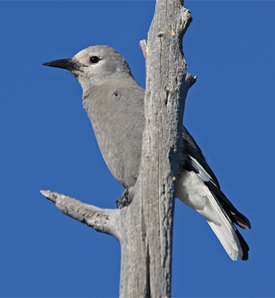 After a mountain pass stop had garnered us our first Red-naped Sapsucker, our final stop of the day was the picturesque Black Canyon and another Pinyon/Juniper site with much potential. Again we were greeted by a surprising number of Pinyon Jays and a huge flock of raucous but beautiful Clark’s Nutcrackers. We waited for our target species to emerge, Northern Pygmy Owl but without much success although as we waited a large accipiter zipped past us that we tentatively ID’d as a Northern Goshawk and spotted towhees called from some scrub whilst a variety of woodpeckers worked the stunted trees. The pygmy owl however wasn’t playing ball and though we had one encouraging but very short hoot we didn’t have enough to add the species to the burgeoning trip list.
After a mountain pass stop had garnered us our first Red-naped Sapsucker, our final stop of the day was the picturesque Black Canyon and another Pinyon/Juniper site with much potential. Again we were greeted by a surprising number of Pinyon Jays and a huge flock of raucous but beautiful Clark’s Nutcrackers. We waited for our target species to emerge, Northern Pygmy Owl but without much success although as we waited a large accipiter zipped past us that we tentatively ID’d as a Northern Goshawk and spotted towhees called from some scrub whilst a variety of woodpeckers worked the stunted trees. The pygmy owl however wasn’t playing ball and though we had one encouraging but very short hoot we didn’t have enough to add the species to the burgeoning trip list.
Day 6
Day six saw us arising early to head out for another chicken lek and another big target species Gunnison Sage Grouse. There were plenty to be seen and as we awaited the action we tried to keep ourselves as warm as possible sitting watching the sun rise behind the mountains that surrounded this stunning marshy lekking ground. Mating season was drawing a close for these extremely rare birds and although there were many birds their was a lot of milling around and half-hearted displaying while only a couple of seemingly unimpressed females popped in to check out the action. As the sun rose in the sky the grouse were off showing their wonderful black bellies in flight as they skipped away across the valley. A couple of Coyotes lazily wandered the edge of the lek looking for a meal and generally intimidated the birds. After returning to the hotel for breakfast and to pick up some mislaid binoculars we were soon on our way again. The feeders at the hotel had a nice little mix of birds and we soon had Black-capped Chickadee and Brewer's Blackbird in the mix.
We headed onwards now making our way south and east and towards more plains and deserts than mountains. We had one last shot at a few mountain specialties and we were not to be disappointed. After carefully working a recommended mountain pass we soon had a very co-operative Three-toed Woodpecker working over some peeling bark – very nice. More Pine Grosbeaks were found and Red Crossbills also put in an 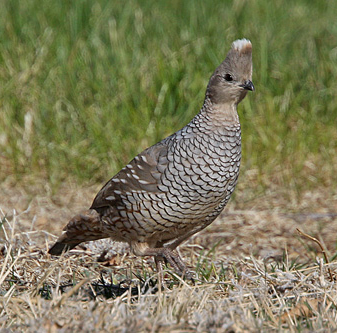 appearance along with their much rarer White-winged Crossbill cousins. Joe’s fantastic ears also picked up a distant Golden-crowned Kinglet which slowly revealed itself to the group, incredible that a bird so small handles such climatic adversity.
appearance along with their much rarer White-winged Crossbill cousins. Joe’s fantastic ears also picked up a distant Golden-crowned Kinglet which slowly revealed itself to the group, incredible that a bird so small handles such climatic adversity.
After a couple of interesting stops we were on to Pueblo West, probably most famous for being an area where Say’s Phoebe was discovered to science. Here we were looking for our first Scaled Quails and with a little (possibly suspicious looking) roving around the subdivision we soon found our quarry ducking in and out of cover as they made use of some well appointed feeders. Another nice pick-up in the area was a pair of Curve-billed Thrashers that were nesting in some cholla right up against a neighborhood house.
Next we were going to explore a few more little stops around Pueblo. Highlights included a nice Green Heron picked out at a local pond, which also had a small group of Wild Turkeys as well as a host of swallows and to be carefully avoided Fire Ant nests. We ended our day with a little stroll through the local park which yielded us our one and only Snow Goose which seemed to be lagging behind his recently departed brethren and a little group of garish Wood Ducks.
Day 7
Our day started with a visit to a few nearby lakes. The surrounding scrub of our first stop also found us a few nice passerine migrants including vocal and brightly colored Western Kingbirds as well as a cracking harlequin faced Lark Sparrow or two and some Black-necked Stilts out on the water. Next stop we were searching mainly for Snowy Plover and within the crusty edges of the lake we soon had our prey. As with all good birding trips our next stop was totally unplanned as we stumbled upon a feedlot pool that was abuzz with activity, including Long-billed Dowitchers, Wilson’s Phalaropes and an array of ducks that included stunning Blue and Cinnamon Teals. As we picked out a few shorebirds from the pool edges and a stopped to snap pictures of the ducks a constant stream of Yellow-headed Blackbirds passed in waves across the track in front of us as they dodged from one feedlot to another.
Another bird that we were hoping to get in the area meant sifting through the large Black-tailed Prairie Dog townships. The targeted Burrowing Owl was none too elusive and we’d soon managed good looks at a few groups of birds for more appreciate oohs and aahs and a few much desired photos. By now of course we were in the heart of flat prairie a rather bizarre experience after the mountains of just a few days previously. In Colorado you seem to hit every possible landscape, from mountains, to river valleys, to grasslands to deserts, in just a handful of days which makes the biodiversity simply incredible.
Next stop was a migratory hotspot and we were not to be disappointed as we picked up some entertaining trip species. Lamar seems to be where East meets West in Colorado and the migrant land birds clearly reflected this and we were treated to both ‘Audubon’s’ and ‘Myrtle’ Yellow-rumped Warbler, Blue Jay and Red-bellied Woodpecker. Other nice additions to the list here included Orange-crowned Warbler, House Wren, Hermit Thrush, Ruby-crowned Kinglet, Lincoln’s Sparrow and a rather surprising Indigo Bunting. Our next little stop was not overly birdy but a great highlight was the pair of Great Horned Owls that disappeared on our arrival but left their downy young to sit in for photographs.
The final part of the day saw us rolling out towards another well known migrant stop. Highlights en route included a wealth of sparrows and other open country specialties including the unfeasibly common Vesper Sparrow, Horned Larks aplenty, unbelievable numbers of Western Meadowlark as well as the rather more sought after Cassin’s and Lark Sparrows as well as a gorgeous Lark Bunting.
Day 8
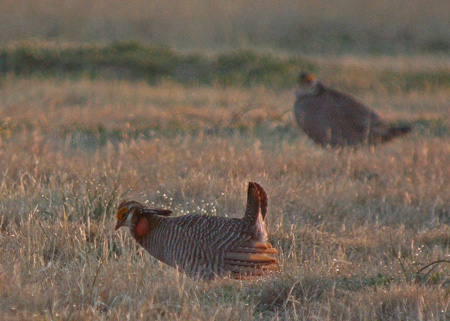 Again we were up early to be out and ready for our penultimate chicken of the tour, Lesser Prairie Chicken. Whilst sat in a rather small shed we sat waiting for the sun to rise and listened intently to the booming of these incredible birds. Not that there wasn’t a great deal more to enjoy as the surrounding prairies rang to the song of Grasshopper Sparrows, Cassin’s Sparrows and Western Meadowlarks. A Burrowing Owl seemed to be extremely put out by the chicken’s deciding to use his turf as a lek and proceeded to flit around, trying in vain to move them on. With reams more photos taken we began to get on the road but not before another much sought over bird, Long-billed Curlew, passed overhead but left us with better views desired.
Again we were up early to be out and ready for our penultimate chicken of the tour, Lesser Prairie Chicken. Whilst sat in a rather small shed we sat waiting for the sun to rise and listened intently to the booming of these incredible birds. Not that there wasn’t a great deal more to enjoy as the surrounding prairies rang to the song of Grasshopper Sparrows, Cassin’s Sparrows and Western Meadowlarks. A Burrowing Owl seemed to be extremely put out by the chicken’s deciding to use his turf as a lek and proceeded to flit around, trying in vain to move them on. With reams more photos taken we began to get on the road but not before another much sought over bird, Long-billed Curlew, passed overhead but left us with better views desired.
After sitting on our backsides for a few hours we decided to get out and have a wander around a highly touted migrant hotspot. It certainly didn’t disappoint with Black-crowned Night-herons a tour tick, Solitary, Spotted and Baird’s Sandpipers a nice little discovery and stunning American Avocets and Wilson’s Phalaropes putting on quite the show as they both swam in a few water features. Not to be outdone by the waders, waterfowl and shorebirds we also stumbled upon a nice little pocket of migrant warblers which included a few stunning Wilson’s Warbler and a rather nice for the state Northern Parula (a nice little tick for most Colorado birders).
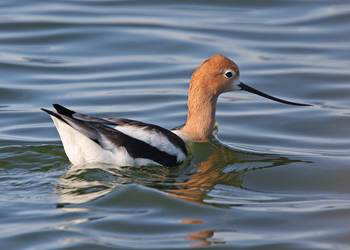 After a little dip into both Oklahoma and Kansas we were on our way again but first we had another stop or two to make looking for some of those more desert related species. We were not to be disappointed with Ladder-backed Woodpecker, Blue-gray gnatcatcher, Black-chinned Hummingbird and Rufous-crowned Sparrow putting in appearances.
After a little dip into both Oklahoma and Kansas we were on our way again but first we had another stop or two to make looking for some of those more desert related species. We were not to be disappointed with Ladder-backed Woodpecker, Blue-gray gnatcatcher, Black-chinned Hummingbird and Rufous-crowned Sparrow putting in appearances.
Another stop on the fly included a rather promising little swale that yielded Eastern Bluebirds, Eastern Phoebes, Red-bellied Woodpecker and a rather vocal pair of nesting Ash-throated Flycatchers. With a lot of ground to cover though we were soon on the road. After a chance encounter upon a pair of Long-billed Curlews allowed close study and some nice snaps and heading, on the trips longest straight drive up to our appointment with today’s chicken’s larger cousin, the Greater Prairie Chicken.
Day 9
Another rewarding early start which had us parked in a dark field surrounded by the haunting calls of Greater Prairie Chicken by about 5:30am. The crescendo built to quite a volume as the light came up and we realized we were quite surrounded by these amazing birds. With a female crouched right down beside the vehicle we soon had a host of eagerly displaying males putting on what must be one of the most amazing bird shows on earth. After soaking up the spectacle for a couple of early morning hours we were on our way again. With a couple of grassland birds under our belt and a White-tailed Ptarmigan that might just be within shot if we cleaned up on the rest that afternoon we were on towards the Pawnee Grasslands via a well known migrant hotspot or two.
Another slew of waterfowl ensued at our morning migrant hotspot including more grebes, ducks and gulls and American White Pelicans as well as such eastern ‘rarities’ as Field Sparrow, Broad-winged Hawk and Northern Cardinal as well as more Eastern Bluebirds and American Kestrels.
In the grasslands we were soon making inroads into the remaining grassland species we had hoped to encounter. Our first Ferruginous Hawk was spotted in flight and was stunningly distinctive and we soon had it tracked down to a nearby nest. As well as the ubiquitous Common Ravens we also had Chihuahuan Ravens for the second day running. Working quickly and efficiently we soon had another target bird although already ticked it was nice to see the McCown’s Longspur skylarking vociferously in its grassland home. Another species much sought after was the sadly declining Mountain Plover and we soon found a couple within the muddy swales of the surrounding prairie. The prairies themselves were stunning, a vast sea of grassland broken only intermittently by the odd stunted tree that might yield a raptors nest or a pair of Loggerhead Shrikes hunting feverishly. All around us meadowlarks and sparrows sung and if you squinted your eyes enough to obliterate the barbed wire fencing you could imagine these amazing plains as they might have seemed to both the Native Americans that called them home and those early explorers of the American expansion period that struck out west.
With that sights and sounds of the grasslands slowly being closed in on by an impending storm we took our leave of these majestic expanses and set off on towards Fort Collins, a remarkably pretty and welcoming city that bustled with nightlife and one rated as the best to live in, in North America for a few years running).
Day 10
After a good nights sleep we were up early again and on the road for a last ditch, Hail Mary shot at clawing back one of the trips most sought after birds, White-tailed Ptarmigan. The road to Loveland Pass was open again and we drove steadily on towards our goal knowing that time was in short supply if we were to get Gary to the airport on time.
We steadily climbed the pass until we reached the magical 12,000ft marker and rolled out the vehicle to scan for our days quarry. Stretched before us were acres upon acres of snow covered mountainsides and here we were looking for an essentially white bird on an austere white background. Bird life in this severe habitat was limited to a few Common Ravens and an American Pipit or two so there was little to distract us from our hunt. We worked the area diligently as we in vain looked again and gain at any slightly anomalous pile of snow.
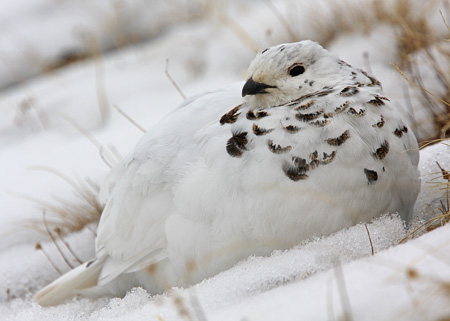 After an hour or so we wandered to another outlook over the pass and as we chatted to another group of birders, the excited call came out that a ptarmigan had been found slightly up slope away from a roadside viewpoint but had rapidly flushed to places unknown. Now however we were on the hunt and we hotfooted it up the escarpment as fast as we could on weary legs and in the thinnest of oxygen depleted air. As we reached the spot 200 yards up slope we suddenly were on the bird. There down below us, brilliantly camouflaged in an area that was dusted with snow, was our days holy grail: White-tailed Ptarmigan. We sat on the slope, slowly allowing the momentous occasion to sink in and reveling in finally seeing this most challenging of birds.
After an hour or so we wandered to another outlook over the pass and as we chatted to another group of birders, the excited call came out that a ptarmigan had been found slightly up slope away from a roadside viewpoint but had rapidly flushed to places unknown. Now however we were on the hunt and we hotfooted it up the escarpment as fast as we could on weary legs and in the thinnest of oxygen depleted air. As we reached the spot 200 yards up slope we suddenly were on the bird. There down below us, brilliantly camouflaged in an area that was dusted with snow, was our days holy grail: White-tailed Ptarmigan. We sat on the slope, slowly allowing the momentous occasion to sink in and reveling in finally seeing this most challenging of birds.
With high fives all around and our journey finally at an end, replete with stunning photographs from near point blank range, we all simply took a moment to lie back on the snow covered slope and soak up both the stunning scenery and the momentousness of the occasion. We had arrived back in the mountains of Colorado after 10 days that had taken us from snow-capped mountains to dusty deserts and all points in-between and scooped up our final prize of the trip; a fittingly exhilarating and wonderful end to this magical trip.
I look forward to taking people to see this magical part of the country again next year.
All photos by Gary Howard.